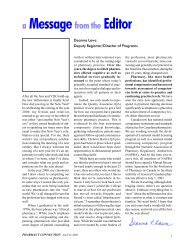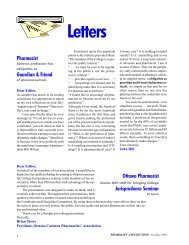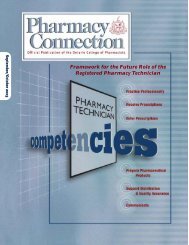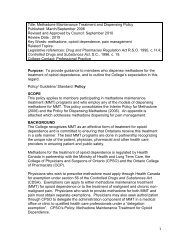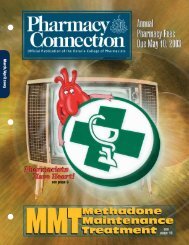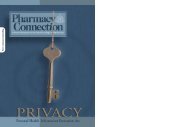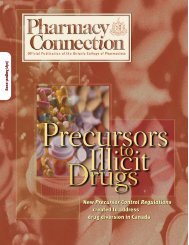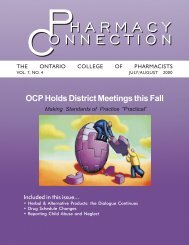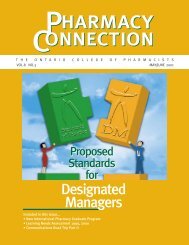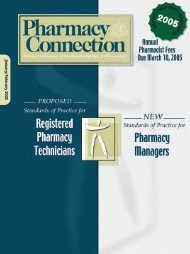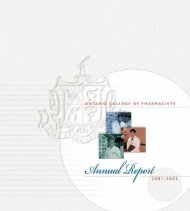Download - Ontario College of Pharmacists
Download - Ontario College of Pharmacists
Download - Ontario College of Pharmacists
Create successful ePaper yourself
Turn your PDF publications into a flip-book with our unique Google optimized e-Paper software.
Understanding What a Technician Can Do . . .<br />
Key to Integration<br />
As more and more pharmacists<br />
embrace their expanded role they<br />
are discovering that changes to<br />
their current workflow may be<br />
required in order to maximize the<br />
time necessary for them to focus<br />
on the delivery <strong>of</strong> these clinical<br />
services.<br />
Integrating a registered pharmacy<br />
technician into practice <strong>of</strong>fers a<br />
viable solution, particularly when<br />
maximizing the technician’s scope.<br />
In order to do this however we<br />
must clearly understand what a<br />
pharmacy technician can do under<br />
their own authority as a regulated<br />
health care pr<strong>of</strong>essional.<br />
In general terms the division <strong>of</strong><br />
responsibilities can be defined as:<br />
• TECHNICIANS are accountable<br />
and responsible for the technical<br />
aspects <strong>of</strong> both new and refill<br />
prescriptions, (i.e. the correct<br />
patient, drug dosage form/route,<br />
dose, doctor) and;<br />
• PHARMACISTS remain<br />
accountable and responsible for<br />
the therapeutic/clinical appropriateness<br />
<strong>of</strong> all new and refill<br />
prescriptions and all therapeutic<br />
consultation.<br />
Each completed prescription must<br />
contain the signature, or some<br />
other identifying mechanism, <strong>of</strong><br />
both the technician (for the technical<br />
functions) and the pharmacist<br />
(for the therapeutic functions).<br />
Pharmacy technicians are also<br />
permitted to accept verbal<br />
prescriptions (with the exception<br />
<strong>of</strong> narcotics and controlled drug<br />
substances) and once legislative<br />
changes to the Food and Drug Act<br />
regulations are in place, will also be<br />
able to independently receive and<br />
provide prescription transfers.<br />
While the objective <strong>of</strong> integration is<br />
to optimize the role <strong>of</strong> the technician<br />
and pharmacist, workflow will<br />
be dependent on a number <strong>of</strong><br />
individual variables: physical layout,<br />
resources/staffing, patient<br />
population/characteristics<br />
etc. There is no ‘one size<br />
fits all’ approach and it is<br />
understood that pharmacies<br />
may face a number <strong>of</strong> barriers.<br />
The <strong>College</strong>’s initial requirement<br />
to have an ‘independent double<br />
check’, as an example, may have<br />
been a barrier to the integration<br />
<strong>of</strong> technicians in some practice<br />
settings. The introduction <strong>of</strong><br />
the Standards <strong>of</strong> Practice for<br />
technicians however allowed<br />
for more flexibility, positioning<br />
the ‘independent double check’<br />
as a best practice rather than a<br />
requirement.<br />
Standards stipulate that whenever<br />
possible, a final check should<br />
be performed by a pharmacy<br />
technician (or a pharmacist) who<br />
did not enter the prescription into<br />
the pharmacy s<strong>of</strong>tware system or<br />
who did not select the drug from<br />
stock. However, if another member<br />
<strong>of</strong> the team is not available, all<br />
technical aspects, including the final<br />
check, can be completed by the<br />
same technician. Remembering <strong>of</strong><br />
course that a prescription cannot<br />
be released to the patient until<br />
a pharmacist has performed the<br />
therapeutic check.<br />
Clearly understanding technician’s<br />
scope <strong>of</strong> practice and standards <strong>of</strong><br />
practice is a key step in identifying<br />
the best way to integrate these<br />
valuable members <strong>of</strong> the health<br />
care team into your pharmacy<br />
practice.<br />
DEFINING EACH ROLE<br />
A pharmacy technician can ensure that this<br />
bottle contains 100 tablets <strong>of</strong> drug ‘x’, and that<br />
the information on the label including; name<br />
<strong>of</strong> patient, prescriber, drug and directions are<br />
correct, as per the prescription.<br />
The pharmacist must have<br />
assessed the patient and<br />
authorized that drug ‘x’ is the<br />
appropriate medication to take,<br />
and counselled the patient on how<br />
to take it.<br />
PHARMACY CONNECTION ~ WINTER 2013 ~ PAGE 13



